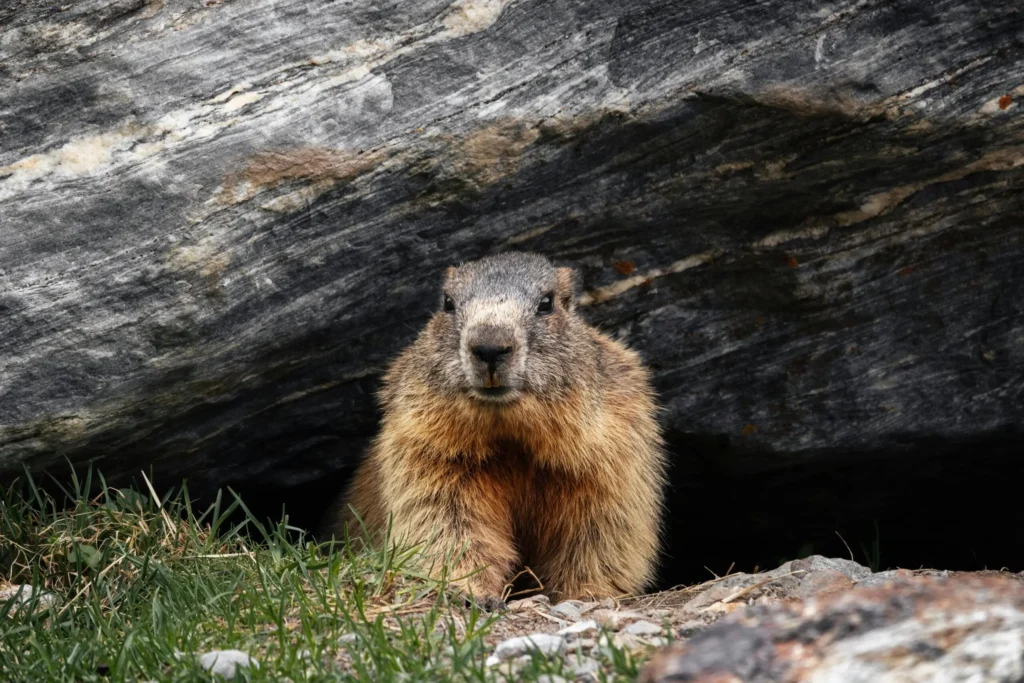
Interesting Wildlife Facts About Groundhogs
- Groundhogs, also known as woodchucks, are members of the squirrel family (Sciuridae).
- They are excellent diggers and can create burrow systems with multiple chambers that can be up to 30 feet long.
- Groundhogs are primarily herbivores, feeding on grasses, fruits, and vegetables.
- They are known for their hibernation behavior; they sleep for about 3–4 months during the winter.
- Groundhogs have a distinctive defense mechanism: they whistle to alert other groundhogs of danger.
Nuisance Issues with Groundhogs
- Damage to Gardens and Crops: Groundhogs can cause significant damage to gardens and crops, especially by chewing through plants and vegetables.
- Burrow Damage: Their burrows can undermine the stability of foundations, sidewalks, and fences.
- Risk to Pets: Groundhogs are generally shy and non-aggressive but may defend themselves if threatened, particularly by pets. However, the risk to pets is minimal unless a direct encounter occurs.
- Soil Erosion: Their digging can lead to erosion and soil instability in agricultural areas.
Groundhog Behavior
- Solitary Behavior: Groundhogs are mostly solitary and are typically active during the day.
- Territorial Nature: They are territorial and will defend their burrows against other groundhogs.
- Foraging Habits: Groundhogs spend a significant amount of time foraging and eating, particularly in the summer and fall to prepare for hibernation.
- Spring Activity: In the spring, groundhogs are especially active, often seen sunbathing, though they are generally solitary and interact with each other primarily during the breeding season.
- Alarm Calls: Groundhogs are known for their unique “whistle,” a high-pitched alarm that signals danger to other groundhogs.
Groundhogs and Diseases
- Rabies: Though rare, groundhogs can carry rabies, which can be transmitted through bites or scratches.
- Tularemia: Groundhogs can carry this bacterial infection, which can be passed to humans through bites, direct handling, or exposure to infected tissues.
- Ectoparasites: Groundhogs may harbor fleas, ticks, and mites, which can spread to pets and humans.
Where in the US Are Groundhogs Found?
- Geographic Distribution: Groundhogs are found throughout the eastern and northern United States, as well as parts of Canada.
- Preferred Habitats: They are particularly common in rural areas, farmland, and wooded regions, where they dig their burrows.
- Suburban Presence: Groundhogs can also be found in suburban areas, but they require nearby burrowing sites like wooded edges, brushy areas, or open fields.
Protecting Your Property from Groundhogs
To protect your property from groundhogs, it’s important to prevent them from burrowing near structures. Start by sealing any openings around foundations, porches, and crawlspaces, as groundhogs can squeeze through surprisingly small gaps. Install a mesh fence that extends at least 18–24 inches underground to prevent digging. Keeping your yard tidy by removing overgrown vegetation, fallen fruits, and garden debris will reduce the attraction for groundhogs. If you’re dealing with an active burrow, consider placing repellents, such as predator urine or commercial groundhog deterrents, around the area. For severe infestations, hiring a professional wildlife removal service can help safely relocate the animals.
